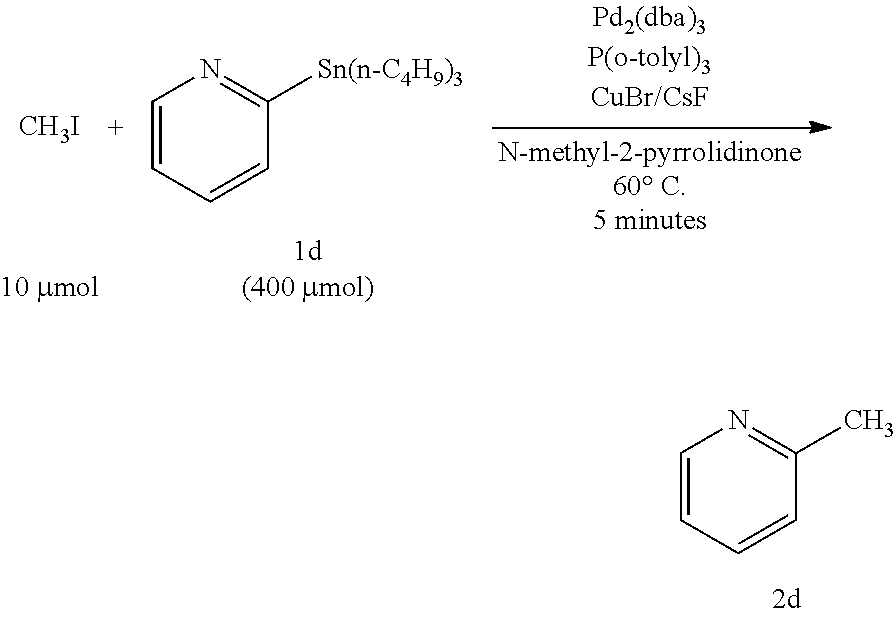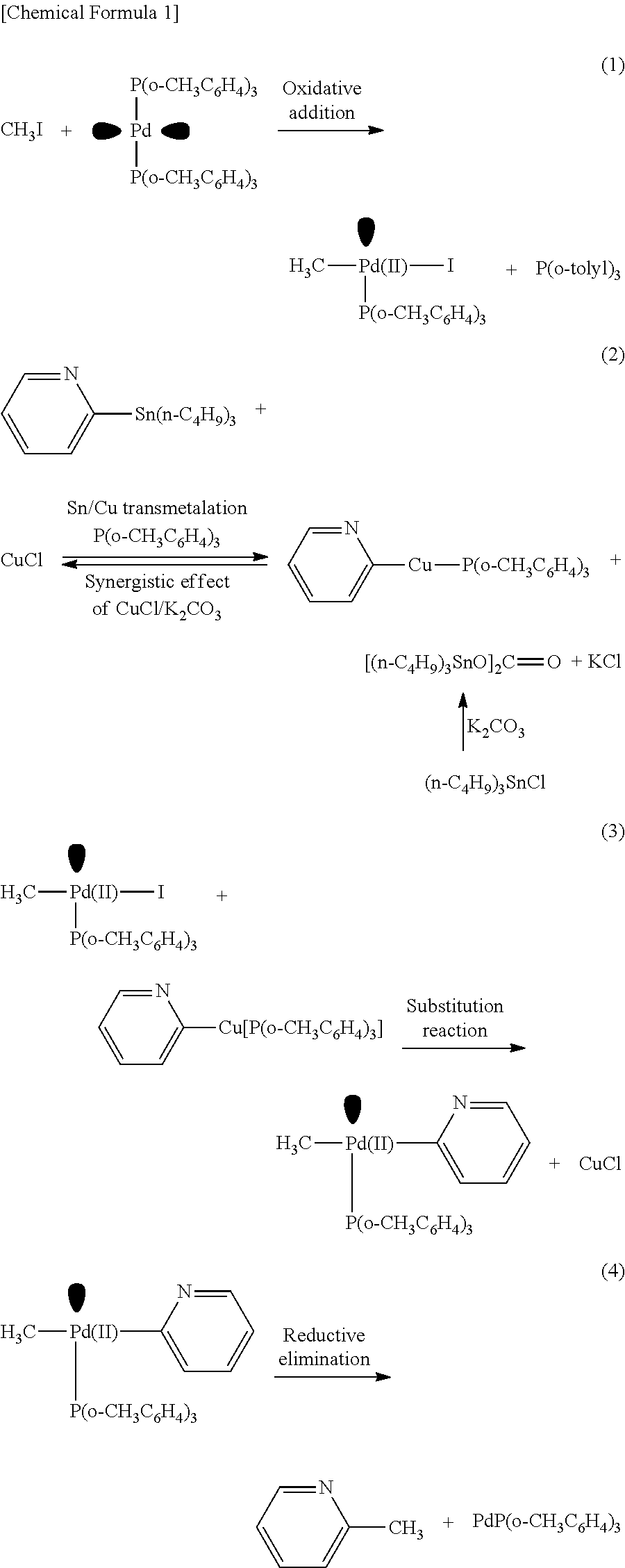Method for rapidly methylating heteroaromatic arene and method for producing tracer for use in PET
a technology of heteroaromatic arene and rapid methylation, which is applied in the field of rapidly methylating heteroaromatic arene and producing tracer for use in pet, can solve the problems of inability to properly diagnose or treat, short half-life, and inability to establish the methods for rapid methylation in high yield, and achieves simple preparation of pet tracer, minimize the effect of cuprous halide as a catalyst poison, and high yield
- Summary
- Abstract
- Description
- Claims
- Application Information
AI Technical Summary
Benefits of technology
Problems solved by technology
Method used
Image
Examples
example 1
METHOD OF EXAMPLE 1
[0062]In the method of Example 1, heteroaromatic aryltrialkylstannanes 1a to 1i were methylated as described below (these are named Examples 1a to 1i, respectively). The respective reagents were added in the following molar ratio: CH3I :stannane:Pd2 (dba)3: P(o-tolyl)3:CuBr:CsF=1:40:0.5:16:2:5. Specifically, under an argon atmosphere, Pd2(dba)3 (4.6 mg, 5.0 μmol), P(o-tolyl)3 (48.8 mg, 160 μmol), CuBr (20 μmol), and CsF (50 μmol) were weighed into a 10 mL Schlenk tube, and NMP (0.5 mL) was added thereto and stirred at room temperature for 5 minutes. Subsequently, an NMP (0.5 mL) solution of one of heteroaromatic aryltrialkylstannanes 1a to 1i (400 μmol) and an NMP solution of CH3I (10 μmol of 12.5 μmol / 0.80 M) were sequentially added, and the mixture was stirred at 60° C. for 5 minutes. After the reaction, the mixture was quickly cooled in an ice bath, and diethyl ether (1 mL) was added thereto. The mixture was loaded on a short column of silica-gel (0.5 g) and el...
example 3
[0078]In Example 3, CuCl and K2CO3 were used in place of CuBr and CsF, respectively, which were used in Example 2. The other reaction conditions were the same as those in Example 2, and a description thereof is omitted here. As a result, 2-methylpyridine (2d) was obtained in a yield of 66%, and the method was found to be usable as a rapid methylation technique. It was also found that as for a combination of a copper halide salt and a scavenger salt, a combination of CuBr—CsF was more preferable than a combination of CuCl—K2CO3.
[0079]Examples 4 to 7 described below are applications of the 11C-labeled methylation using 11C methyl iodide as a starting material. Examples 4 to 6 are each an example of a method for rapidly methylating heteroaromatic arene using a two-pot process, which includes providing two reaction vessels, performing a process of preparing a palladium complex in the first reaction vessel, performing a process of preparing heteroaromatic aryl copper in the second reacti...
example 4
Synthesis of 3-[11C]picoline Using CuBr and CsF
[0080]An NMP solution (0.27 mL) of trisdibenzylideneacetone dipalladium (2.5 mg, 2.7 μmol) and tri-o-tolylphosphine (13 mg, 44 μmol) was prepared in a reaction vessel (A) and kept at room temperature. The solution was prepared in the reaction vessel (A) 10 to 20 minutes before [11C] methyl iodide was blown into the vessel.
[0081]An NMP solution (60 mL) of (3-pyridinyl)tributylstannane (3.0 mg, 8.1 μmol) as a tin precursor, CuBr (0.78 mg, 5.4 μmol), and CsF (2.1 mg, 14 μmol) was prepared in a reaction vessel (B) and kept at room temperature. Subsequently, [11C]methyl iodide was blown at a gas flow rate of 60-80 mL / min into the reaction vessel (A), and then the mixture was allowed to stand for 1 minute. The resulting solution was transferred to the reaction vessel (B). The mixed solution in the reaction vessel (B) was heated at 60° C. for 5 minutes. The resulting reaction solution was diluted with 2 mL of acetonitrile and then filtered thr...
PUM
| Property | Measurement | Unit |
|---|---|---|
| molar ratio | aaaaa | aaaaa |
| gas flow rate | aaaaa | aaaaa |
| time | aaaaa | aaaaa |
Abstract
Description
Claims
Application Information
 Login to View More
Login to View More - R&D
- Intellectual Property
- Life Sciences
- Materials
- Tech Scout
- Unparalleled Data Quality
- Higher Quality Content
- 60% Fewer Hallucinations
Browse by: Latest US Patents, China's latest patents, Technical Efficacy Thesaurus, Application Domain, Technology Topic, Popular Technical Reports.
© 2025 PatSnap. All rights reserved.Legal|Privacy policy|Modern Slavery Act Transparency Statement|Sitemap|About US| Contact US: help@patsnap.com



